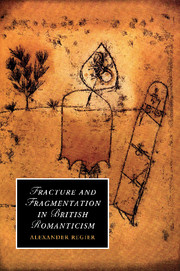Book contents
- Frontmatter
- Contents
- Acknowledgements
- List of abbreviations
- Broken origins: an introduction
- 1 A brotherhood is broken: Babel and the fragmentation of language
- 2 Figuring it out: the origin of language and anthropomorphism
- 3 Forces trembling underneath: the Lisbon earthquake and the sublime
- 4 A blue chasm: Wordsworth's The Prelude and the figure of parenthesis
- 5 Letters from the grave: John Keats's fragmented corpus
- 6 The doubling force of citation: De Quincey's Wordsworthian archive
- 7 Philological fractures: Paul de Man's Romantic rhetoric
- Notes
- Bibliography
- Index
- CAMBRIDGE STUDIES IN ROMANTICISM
4 - A blue chasm: Wordsworth's The Prelude and the figure of parenthesis
Published online by Cambridge University Press: 06 July 2010
- Frontmatter
- Contents
- Acknowledgements
- List of abbreviations
- Broken origins: an introduction
- 1 A brotherhood is broken: Babel and the fragmentation of language
- 2 Figuring it out: the origin of language and anthropomorphism
- 3 Forces trembling underneath: the Lisbon earthquake and the sublime
- 4 A blue chasm: Wordsworth's The Prelude and the figure of parenthesis
- 5 Letters from the grave: John Keats's fragmented corpus
- 6 The doubling force of citation: De Quincey's Wordsworthian archive
- 7 Philological fractures: Paul de Man's Romantic rhetoric
- Notes
- Bibliography
- Index
- CAMBRIDGE STUDIES IN ROMANTICISM
Summary
These kirkmen have done Scotland harm – they have banished puns and laughing and kissing (except in cases where the very danger and crime must make it very fine and gustful). I shall make a full stop after kissing for after that there should be a better parent-thesis: and go on to remind you of the fate of Burns.
In the first chapter of this book I tried to show how an image of fragmentation such as the ‘fragment of a wooden bowl’ in The Ruined Cottage can play a metonymic role in signifying a larger concern with fragmentation in Wordsworth's poetry. The present chapter wants to illustrate how fracture weaves itself into Wordsworth's texts syntactically, namely, by way of a rhetorical and grammatical figure. The analysis will concentrate on the figure of parenthesis. To ensure a clear focus, I will limit the reading of this figure – at once rhetorical and grammatical – to some specific moments in The Prelude.
Parenthesis is both a punctuation mark and a rhetorical figure. The syntactical break in a textual structure by means of a parenthetical sign is fundamentally disruptive in its effects. Grammatical treatises of the eighteenth century, which often include a section or chapter on parenthesis, are as insistent on this as today's reference works. Parenthesis, both as a grammatical unit and as a rhetorical move, produces a hiatus and a fracture in thought and language.
- Type
- Chapter
- Information
- Fracture and Fragmentation in British Romanticism , pp. 95 - 118Publisher: Cambridge University PressPrint publication year: 2010

